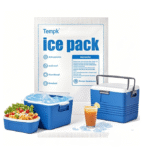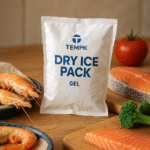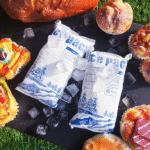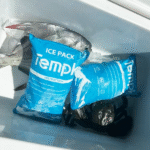Diferencia entre hielo seco y paquete de gel: Lo cual es adecuado para sus necesidades?
Elegir entre dry ice and gel packs is a common dilemma when it comes to shipping temperature-sensitive goods. Both options are designed to keep products cool, but they work differently and are suited for specific needs. En esta guía, we’ll explore the key differences between dry ice and gel packs, helping you determine which option best suits your cold chain requirements.
-
How dry ice and gel packs differ in cooling methods
-
Best applications for dry ice and gel packs
-
Cost and environmental considerations for each option
-
When to choose one over the other based on your shipment’s needs
-
Practical tips for safely using both dry ice and gel packs
How Do Dry Ice and Gel Packs Differ in Cooling?
El hielo seco es dióxido de carbono sólido (Co₂) that sublimates at –78.5°C, haciéndolo ideal para envío ultra fría, keeping products frozen for extended periods. En contraste, gel packs use a phase-change material (PCM) to keep contents cool, typically between 0–8°C, and are designed for refrigerated goods rather than frozen items.
While dry ice offers longer cooling durations at much lower temperatures, gel packs are easier to handle, more environmentally friendly, and typically more cost‑effective for shorter durations.
Paquetes de hielo seco vs gel: Diferencias clave
| Método de enfriamiento | Rango de temperatura | Uso ideal | Duración del enfriamiento |
|---|---|---|---|
| Hielo seco | –78.5 ° C | comida congelada, productos farmaceuticos, biológicos | 24–72 horas |
| Paquetes de gel | 0–8 ° C | Artículos refrigerados, suministros médicos | 12–48 horas |
Consejos prácticos
-
For frozen goods: Dry ice is your best option for maintaining subzero temperatures over extended periods.
-
For refrigerated goods: Gel packs are perfect for keeping products within the 2–8°C range for 1–2 days.
-
For mixed shipments: Use both—dry ice for frozen products and gel packs for refrigerated items.
Ejemplo de vida real: A logistics company successfully shipped vaccines using gel packs for refrigerated items and dry ice for biologics that required freezing temperatures, ensuring that both stayed within optimal temperature ranges.
When Should You Use Dry Ice Over Gel Packs?
Dry ice is the go‑to solution when you need to keep items frozen at subzero temperatures. This makes it ideal for long shipments of frozen foods, productos farmaceuticos, y muestras biológicas that must stay below –20°C or colder.
Dry ice provides a powerful cooling effect and is typically used for shipments that last more than 24 horas. Sin embargo, dry ice requires proper ventilation and handling to avoid carbon dioxide buildup, making it less convenient for smaller shipments or short durations.
Best Uses for Dry Ice
-
Alimentos Congelados: Use dry ice to keep ice cream, carnes congeladas, or seafood solid for days.
-
Farmacéuticos y biológicos: Certain medications, como vacunas, need to stay at low temperatures, which dry ice can easily provide.
-
Long‑Term Transport: Dry ice is perfect for shipments that need to remain frozen for extended periods.
When to Choose Dry Ice for Your Shipment
| Tipo de envío | Dry Ice Effectiveness | Gel Packs Effectiveness | El mejor uso |
|---|---|---|---|
| Alimentos Congelados | Highly effective | Ineficaz | Dry ice for extended trips |
| Productos farmacéuticos | Highly effective | Ineficaz | Dry ice for frozen shipments |
| Biológicos | Highly effective | Ineficaz | Dry ice for temperature control |
When Should You Use Gel Packs Over Dry Ice?
Gel packs are ideal for refrigerated goods that need to stay at temperatures between 0–8°C. This makes them perfect for shorter shipments of food, medicamentos, or personal care products that don’t require freezing temperatures.
Gel packs are also easier to handle y no tóxico, making them suitable for a wider range of goods. They are often the more cost-effective option for short-term temperature control compared to dry ice.
Best Uses for Gel Packs
-
Suministros médicos: Keep medications such as insulin or antibiotics cool for short durations.
-
Alimentos perecederos: Use gel packs for fruits, lácteos, and vegetables that need refrigeration but not freezing.
-
Consumer Goods: Ideal for cosmetics or personal care products that need a cool, temperatura estable.
When to Choose Gel Packs for Your Shipment
| Tipo de envío | Gel Packs Effectiveness | Dry Ice Effectiveness | El mejor uso |
|---|---|---|---|
| Alimentos refrigerados | Highly effective | Ineficaz | Gel packs for shorter trips |
| Productos farmacéuticos | Highly effective | Ineficaz | Gel packs for refrigerated meds |
| Productos cosméticos | Highly effective | Ineficaz | Gel packs for temperature‑sensitive items |
Costo y consideraciones ambientales: Paquetes de hielo seco vs gel
Dry ice is more effective for ultra‑cold shipping, but it comes with higher costs and environmental concerns due to the CO₂ emissions. Dry ice also needs to be replenished regularly, especialmente durante los largos envíos.
Gel packs are more environmentally friendly y reutilizable, which makes them a solución rentable for shorter transit times. They don’t require special handling, are less likely to cause safety issues, and can be easily disposed of without environmental harm.
Comparación de costos: Paquetes de hielo seco vs gel
| Método de enfriamiento | Average Cost per Shipment | Impacto ambiental | El mejor uso |
|---|---|---|---|
| Hielo seco | $25- $ 50 | Alto (Emisiones de co₂) | Long‑term frozen goods |
| Paquetes de gel | $10- $ 30 | Bajo (no tóxico, reutilizable) | Short‑term refrigerated goods |
2025 Tendencias en la logística de la cadena de frío: Innovations and Regulations
A medida que evoluciona la industria de la cadena de frío, 2025 trends highlight the growing demand for sustainable and efficient cooling solutions. Gel packs are becoming more eco-friendly with recyclable or biodegradable options, y new dry ice technologies are being developed to reduce sublimation rates and minimize environmental impact.
Últimas tendencias
-
Embalaje sostenible: New biodegradable gel packs and insulation materials are becoming more common.
-
Smart cooling technology: Temperature monitoring systems integrated with dry ice and gel pack shipping solutions to ensure product integrity.
-
Energy-efficient logistics: Companies are seeking ways to reduce the carbon footprint of long‑distance shipments.
Insight del mercado: The global demand for sustainable cold chain solutions has risen 20% en 2024, driven by stricter environmental regulations and consumer demand for eco‑friendly products.
Preguntas frecuentes {#preguntas frecuentes}
q: Can I use gel packs for items that need to stay frozen?
No, gel packs are designed for refrigeration (0–8 ° C). For freezing requirements, dry ice is necessary.
q: How long do gel packs last during shipping?
Gel packs can keep items cool for 12–48 hours, depending on the insulation and outside temperature.
q: Are there any environmental concerns with using dry ice?
Sí, dry ice releases CO₂ gas as it sublimates, which contributes to greenhouse gas emissions. Proper handling and disposal are required.
Resumen & Comida para llevar
Dry ice and gel packs are both essential for temperature-sensitive shipments, but they are suited for different needs. Use dry ice for freezing temperatures and longer shipments. Opt for gel packs when you need to maintain cooler temperatures for shorter durations. Consider cost, impacto ambiental, and your specific shipping requirements when making the decision.
Que hacer a continuación
-
Calculate your shipment’s cooling needs using our guide.
-
Order gel packs or dry ice from Tempk for your next shipment.
-
Comparte esta guía with your logistics team to ensure the best cooling solution.
Acerca de Tempk
Tempk provides advanced cold chain logistics solutions, offering gel packs, hielo seco, and customized temperature-controlled packaging. We ensure your temperature-sensitive shipments arrive at their destination in optimal condition, si está enviando productos farmacéuticos, alimento, o biológicos.
Necesita soluciones de cadena fría a medida? Contáctenos for expert advice and guidance.
























